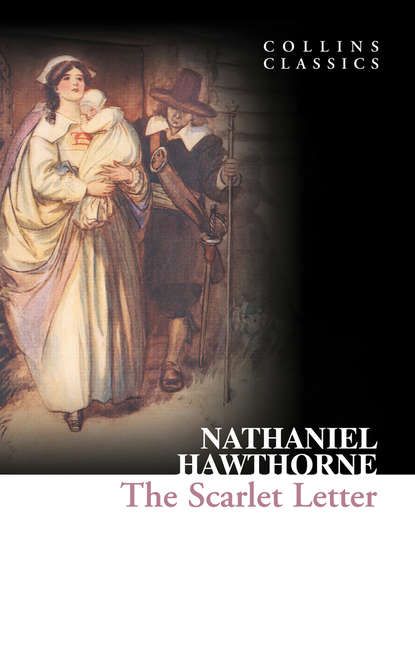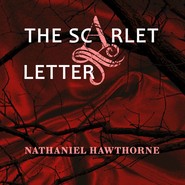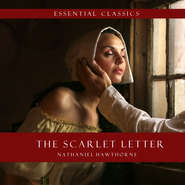По всем вопросам обращайтесь на: info@litportal.ru
(©) 2003-2024.
✖
The Scarlet Letter
Настройки чтения
Размер шрифта
Высота строк
Поля
The Scarlet Letter
Nathaniel Hawthorne
HarperCollins is pround to present a range of best-loved, essential classics.'Ah, but let her cover the mark as she will, the pang of it will be always in her heart.'A tale of sin, punishment and atonement, The Scarlet Letter exposes the moral rigidity of a 17th-Century Puritan New England community when faced with the illegitimate child of a young mother. Regarded as the first real heroine of American fiction, it is Hester Prynne's strength of character that resonates with the reader when her harsh sentence is cast. It is in her refusal to reveal the identity of the father in the face of her accusers that Hawthorne champions his heroine and berates the weakness of Society for attacking the innocent.
The Scarlet Letter
History of Collins (#ulink_4fbc8217-74c2-5823-85e2-ea8821ef3197)
In 1819, Millworker William Collins from Glasgow, Scotland, set up a company for printing and publishing pamphlets, sermons, hymn books and prayer books. That company was Collins and was to mark the birth of HarperCollins Publishers as we know it today. The long tradition of Collins dictionary publishing can be traced back to the first dictionary William published in 1824, Greek and English Lexicon. Indeed, from 1840 onwards, he began to produce illustrated dictionaries and even obtained a licence to print and publish the Bible.
Soon after, William published the first Collins novel, Ready Reckoner, however it was the time of the Long Depression, where harvests were poor, prices were high, potato crops had failed and violence was erupting in Europe. As a result, many factories across the country were forced to close down and William chose to retire in 1846, partly due to the hardships he was facing.
Aged 30, William’s son, William II took over the business. A keen humanitarian with a warm heart and a generous spirit, William II was truly ‘Victorian’ in his outlook. He introduced new, up-to-date steam presses and published affordable editions of Shakespeare’s works and Pilgrim’s Progress, making them available to the masses for the first time. A new demand for educational books meant that success came with the publication of travel books, scientific books, encyclopaedias and dictionaries. This demand to be educated led to the later publication of atlases and Collins also held the monopoly on scripture writing at the time.
In the 1860s Collins began to expand and diversify and the idea of ‘books for the millions’ was developed. Affordable editions of classical literature were published and in 1903 Collins introduced 10 titles in their Collins Handy Illustrated Pocket Novels. These proved so popular that a few years later this had increased to an output of 50 volumes, selling nearly half a million in their year of publication. In the same year, The Everyman’s Library was also instituted, with the idea of publishing an affordable library of the most important classical works, biographies, religious and philosophical treatments, plays, poems, travel and adventure. This series eclipsed all competition at the time and the introduction of paperback books in the 1950s helped to open that market and marked a high point in the industry.
HarperCollins is and has always been a champion of the classics and the current Collins Classics series follows in this tradition – publishing classical literature that is affordable and available to all. Beautifully packaged, highly collectible and intended to be reread and enjoyed at every opportunity.
Life & Times (#ulink_cc4798df-4086-5f31-89a4-0192c2f88713)
About the Author
Nathaniel Hawthorne was born in 1804, with the surname Hathorne. It is widely thought that the reason for the spelling change was that he hailed from the town of Salem, where a number of his relatives had been involved with the infamous witch trials that took place in the closing decade of the 1600s. In fact, his great grandfather, John, had been an executioner. Nathaniel did publish some early material using his original surname however, so it seems more likely that he changed it to save confusion over spelling as it was pronounced in a similar way to ‘Hawthorne’ anyway.
Hawthorne was unsure of his abilities as a writer initially, publishing his first novel Fanshawe anonymously in 1828. In addition, there was no established market for novels so he remained only locally known as a writer until he published The Scarlet Letter in 1850. By then it was possible to mass produce books and this title was one of the first in American literary history. The book also sold well and enabled Hawthorne to become a professional author at a time when one could count them all on one hand.
In a more competitive environment Hawthorne may not have done so well, but as it was he had a ready market waiting to buy his books. Despite their morbidity and intensity they sold well because people had developed a taste for reading fiction. In part this was due to the establishment of stable and polite society in America since the dust had settled from the revolution. It became fashionable to be seen to have the time to read and it gave like-minded people a talking point over dinner and during other social occasions.
Hawthorne was undoubtedly skilled at his craft. He wrote well, had an eye for literary detail and understood that allegory was a useful devise in ensuring that readers got more from his books than just a good story. In this regard he was at odds with Edgar Allan Poe, who was more freeform with his words, indulging in prose that explored the recesses of his imagination without being moralistic or allegorical. One might say that Poe used writing as an art form, while Hawthorne used it as a craft. He took a pragmatic approach by being more mindful of what his readership would wish to read. Poe worked with creative abandon, coming up with ever more challenging visions.
Hawthorne took a wife, Sophia Peabody, with whom he had three children. Sophia moved to England with her children following Hawthorne’s death in 1864. She was an accomplished artist and a member of the American transcendentalist movement, which promoted the idea of individualistic spiritualism as a means of attaining a heightened state of mind, as opposed to indoctrination by organized religion. This was not something that her husband particularly concurred with and he used his later writing to criticize its principles.
The Themes of the Novel
Nathaniel Hawthorne was given to writing extremely intense and dark prose. The Scarlet Letter is rather like the recollection of a feverish nightmare. It doesn’t so much invite the reader in, as pull them in, and then attempt to suffocate them with depressing allegory about what can happen to people when they break the moral and ethical codes of civilized society.
This is an American novel, yet it is more puritanical than most Victorian novels, of which it was contemporaneous, being published in 1850. Hawthorne seems not to have been overly religious himself, but he explores themes of strict doctrine by setting the book in a 17th-century Boston, where Puritanism is in its heyday. So, this book is a period novel of its day, harking back to an era when misbehaviour could have dire consequences
The Puritans were, in essence, very conservative Protestants with intransigent beliefs about good and bad behaviour. This censorious moral view was especially stern when it came to matters of pleasure, including sex. The Protestant church had risen in reaction to the lax excesses of the Catholic Church, which either drew a blind eye to behavioural weakness or allowed people to confess their sins. The Puritans took things as far as they could the other way, so that punishment and penance were the outcome for anyone who broke the rules. Of course, one had to share the same belief system in order to understand and agree to such measures. This seems to be the central theme that Hawthorne is addressing and exploring in The Scarlet Letter.
Some literary scholars have interpreted the book as an expression of Hawthorne’s own view that 19
-society was sliding into a moral and ethical morass, and therefore in need of reform. Others have taken it the other way, by suggesting that Hawthorne was fundamentally a liberal thinker and was actually celebrating a more open-minded modernity by reminding society of how repressive things used to be. Either way, The Scarlet Letter is not a book to be taken lightly, which is why Hawthorne’s genre is often described as ‘dark romanticism’.
Unlike in England, professional novel writing was not well established in America during the first half of the 19th century. The agenda for early American writers was somehow different, perhaps because of the relative lack of historical context and a ubiquitously defined cultural identity. American Independence had only been declared in 1776 and the nation was a melting pot of old and new settlers. This meant that certain themes for novels would have specific readerships. To write something that captured the ‘American’ imagination more generally was a tall order.
As a consequence of this, Hawthorne retreated into an imagined world of extremes with his literature. Other American writers, such as Edgar Allan Poe, were doing similar things in their attempts to emerge as novelists. The Scarlet Letter is set in pre-independent America, so that it carries a sense of history and legacy, as well as it being an allegorical tale about the moral fortitude of American founders.
In fact, it also criticizes the enemy, the English, as the central characters plan to escape their tormentors by travelling across the Atlantic to a new life free from persecution. This is clearly a statement suggesting that England is a place of refuge because it is relatively iniquitous. As it goes, that was quite true by definition, for the majority of early American settlers had travelled to the New World precisely because they wished to establish colonies run by firm religious regime, away from those who lacked the suitable fibre. What they hadn’t reckoned on was that society naturally comprises a spectrum of personality types whatever the intended societal ethos, as a result of nature and nurture. So, there will always be subversive individuals, who cannot and will not adhere to mores, conventions and orthodoxies imposed upon them by others.
Table of Contents
Cover Page (#u45e6e09d-a6ef-5be9-ab92-9442bf012cf7)
Title Page (#u8933d4ac-6c61-5e44-a6c0-d6f768203d8e)
History of Collins (#uddfdb49e-1e0d-5dc4-8f00-9f451e93c3fc)
Life & Times (#u2ace961a-3b42-57c4-8230-f44653ad2e7a)
The Custom-House: Introductory to ‘The Scarlet Letter’ (#u2b45bbbe-530a-5080-95cb-003729fbec7b)
CHAPTER 1 (#u61913f73-5e5b-5839-969d-22762438fab0)
CHAPTER 2 (#u3abafb5b-6228-51b0-b89a-bd4eb55ac37b)
CHAPTER 3 (#u1e094265-56ce-5f81-ba6e-fd876f8f70e3)
CHAPTER 4 (#u96aa2c73-7ae9-5427-af0b-7f7fefec3bb2)
CHAPTER 5 (#litres_trial_promo)
CHAPTER 6 (#litres_trial_promo)
CHAPTER 7 (#litres_trial_promo)
CHAPTER 8 (#litres_trial_promo)
CHAPTER 9 (#litres_trial_promo)
CHAPTER 10 (#litres_trial_promo)
CHAPTER 11 (#litres_trial_promo)
CHAPTER 12 (#litres_trial_promo)
CHAPTER 13 (#litres_trial_promo)
CHAPTER 14 (#litres_trial_promo)
CHAPTER 15 (#litres_trial_promo)
CHAPTER 16 (#litres_trial_promo)
CHAPTER 17 (#litres_trial_promo)
CHAPTER 18 (#litres_trial_promo)
CHAPTER 19 (#litres_trial_promo)
Nathaniel Hawthorne
HarperCollins is pround to present a range of best-loved, essential classics.'Ah, but let her cover the mark as she will, the pang of it will be always in her heart.'A tale of sin, punishment and atonement, The Scarlet Letter exposes the moral rigidity of a 17th-Century Puritan New England community when faced with the illegitimate child of a young mother. Regarded as the first real heroine of American fiction, it is Hester Prynne's strength of character that resonates with the reader when her harsh sentence is cast. It is in her refusal to reveal the identity of the father in the face of her accusers that Hawthorne champions his heroine and berates the weakness of Society for attacking the innocent.
The Scarlet Letter
History of Collins (#ulink_4fbc8217-74c2-5823-85e2-ea8821ef3197)
In 1819, Millworker William Collins from Glasgow, Scotland, set up a company for printing and publishing pamphlets, sermons, hymn books and prayer books. That company was Collins and was to mark the birth of HarperCollins Publishers as we know it today. The long tradition of Collins dictionary publishing can be traced back to the first dictionary William published in 1824, Greek and English Lexicon. Indeed, from 1840 onwards, he began to produce illustrated dictionaries and even obtained a licence to print and publish the Bible.
Soon after, William published the first Collins novel, Ready Reckoner, however it was the time of the Long Depression, where harvests were poor, prices were high, potato crops had failed and violence was erupting in Europe. As a result, many factories across the country were forced to close down and William chose to retire in 1846, partly due to the hardships he was facing.
Aged 30, William’s son, William II took over the business. A keen humanitarian with a warm heart and a generous spirit, William II was truly ‘Victorian’ in his outlook. He introduced new, up-to-date steam presses and published affordable editions of Shakespeare’s works and Pilgrim’s Progress, making them available to the masses for the first time. A new demand for educational books meant that success came with the publication of travel books, scientific books, encyclopaedias and dictionaries. This demand to be educated led to the later publication of atlases and Collins also held the monopoly on scripture writing at the time.
In the 1860s Collins began to expand and diversify and the idea of ‘books for the millions’ was developed. Affordable editions of classical literature were published and in 1903 Collins introduced 10 titles in their Collins Handy Illustrated Pocket Novels. These proved so popular that a few years later this had increased to an output of 50 volumes, selling nearly half a million in their year of publication. In the same year, The Everyman’s Library was also instituted, with the idea of publishing an affordable library of the most important classical works, biographies, religious and philosophical treatments, plays, poems, travel and adventure. This series eclipsed all competition at the time and the introduction of paperback books in the 1950s helped to open that market and marked a high point in the industry.
HarperCollins is and has always been a champion of the classics and the current Collins Classics series follows in this tradition – publishing classical literature that is affordable and available to all. Beautifully packaged, highly collectible and intended to be reread and enjoyed at every opportunity.
Life & Times (#ulink_cc4798df-4086-5f31-89a4-0192c2f88713)
About the Author
Nathaniel Hawthorne was born in 1804, with the surname Hathorne. It is widely thought that the reason for the spelling change was that he hailed from the town of Salem, where a number of his relatives had been involved with the infamous witch trials that took place in the closing decade of the 1600s. In fact, his great grandfather, John, had been an executioner. Nathaniel did publish some early material using his original surname however, so it seems more likely that he changed it to save confusion over spelling as it was pronounced in a similar way to ‘Hawthorne’ anyway.
Hawthorne was unsure of his abilities as a writer initially, publishing his first novel Fanshawe anonymously in 1828. In addition, there was no established market for novels so he remained only locally known as a writer until he published The Scarlet Letter in 1850. By then it was possible to mass produce books and this title was one of the first in American literary history. The book also sold well and enabled Hawthorne to become a professional author at a time when one could count them all on one hand.
In a more competitive environment Hawthorne may not have done so well, but as it was he had a ready market waiting to buy his books. Despite their morbidity and intensity they sold well because people had developed a taste for reading fiction. In part this was due to the establishment of stable and polite society in America since the dust had settled from the revolution. It became fashionable to be seen to have the time to read and it gave like-minded people a talking point over dinner and during other social occasions.
Hawthorne was undoubtedly skilled at his craft. He wrote well, had an eye for literary detail and understood that allegory was a useful devise in ensuring that readers got more from his books than just a good story. In this regard he was at odds with Edgar Allan Poe, who was more freeform with his words, indulging in prose that explored the recesses of his imagination without being moralistic or allegorical. One might say that Poe used writing as an art form, while Hawthorne used it as a craft. He took a pragmatic approach by being more mindful of what his readership would wish to read. Poe worked with creative abandon, coming up with ever more challenging visions.
Hawthorne took a wife, Sophia Peabody, with whom he had three children. Sophia moved to England with her children following Hawthorne’s death in 1864. She was an accomplished artist and a member of the American transcendentalist movement, which promoted the idea of individualistic spiritualism as a means of attaining a heightened state of mind, as opposed to indoctrination by organized religion. This was not something that her husband particularly concurred with and he used his later writing to criticize its principles.
The Themes of the Novel
Nathaniel Hawthorne was given to writing extremely intense and dark prose. The Scarlet Letter is rather like the recollection of a feverish nightmare. It doesn’t so much invite the reader in, as pull them in, and then attempt to suffocate them with depressing allegory about what can happen to people when they break the moral and ethical codes of civilized society.
This is an American novel, yet it is more puritanical than most Victorian novels, of which it was contemporaneous, being published in 1850. Hawthorne seems not to have been overly religious himself, but he explores themes of strict doctrine by setting the book in a 17th-century Boston, where Puritanism is in its heyday. So, this book is a period novel of its day, harking back to an era when misbehaviour could have dire consequences
The Puritans were, in essence, very conservative Protestants with intransigent beliefs about good and bad behaviour. This censorious moral view was especially stern when it came to matters of pleasure, including sex. The Protestant church had risen in reaction to the lax excesses of the Catholic Church, which either drew a blind eye to behavioural weakness or allowed people to confess their sins. The Puritans took things as far as they could the other way, so that punishment and penance were the outcome for anyone who broke the rules. Of course, one had to share the same belief system in order to understand and agree to such measures. This seems to be the central theme that Hawthorne is addressing and exploring in The Scarlet Letter.
Some literary scholars have interpreted the book as an expression of Hawthorne’s own view that 19
-society was sliding into a moral and ethical morass, and therefore in need of reform. Others have taken it the other way, by suggesting that Hawthorne was fundamentally a liberal thinker and was actually celebrating a more open-minded modernity by reminding society of how repressive things used to be. Either way, The Scarlet Letter is not a book to be taken lightly, which is why Hawthorne’s genre is often described as ‘dark romanticism’.
Unlike in England, professional novel writing was not well established in America during the first half of the 19th century. The agenda for early American writers was somehow different, perhaps because of the relative lack of historical context and a ubiquitously defined cultural identity. American Independence had only been declared in 1776 and the nation was a melting pot of old and new settlers. This meant that certain themes for novels would have specific readerships. To write something that captured the ‘American’ imagination more generally was a tall order.
As a consequence of this, Hawthorne retreated into an imagined world of extremes with his literature. Other American writers, such as Edgar Allan Poe, were doing similar things in their attempts to emerge as novelists. The Scarlet Letter is set in pre-independent America, so that it carries a sense of history and legacy, as well as it being an allegorical tale about the moral fortitude of American founders.
In fact, it also criticizes the enemy, the English, as the central characters plan to escape their tormentors by travelling across the Atlantic to a new life free from persecution. This is clearly a statement suggesting that England is a place of refuge because it is relatively iniquitous. As it goes, that was quite true by definition, for the majority of early American settlers had travelled to the New World precisely because they wished to establish colonies run by firm religious regime, away from those who lacked the suitable fibre. What they hadn’t reckoned on was that society naturally comprises a spectrum of personality types whatever the intended societal ethos, as a result of nature and nurture. So, there will always be subversive individuals, who cannot and will not adhere to mores, conventions and orthodoxies imposed upon them by others.
Table of Contents
Cover Page (#u45e6e09d-a6ef-5be9-ab92-9442bf012cf7)
Title Page (#u8933d4ac-6c61-5e44-a6c0-d6f768203d8e)
History of Collins (#uddfdb49e-1e0d-5dc4-8f00-9f451e93c3fc)
Life & Times (#u2ace961a-3b42-57c4-8230-f44653ad2e7a)
The Custom-House: Introductory to ‘The Scarlet Letter’ (#u2b45bbbe-530a-5080-95cb-003729fbec7b)
CHAPTER 1 (#u61913f73-5e5b-5839-969d-22762438fab0)
CHAPTER 2 (#u3abafb5b-6228-51b0-b89a-bd4eb55ac37b)
CHAPTER 3 (#u1e094265-56ce-5f81-ba6e-fd876f8f70e3)
CHAPTER 4 (#u96aa2c73-7ae9-5427-af0b-7f7fefec3bb2)
CHAPTER 5 (#litres_trial_promo)
CHAPTER 6 (#litres_trial_promo)
CHAPTER 7 (#litres_trial_promo)
CHAPTER 8 (#litres_trial_promo)
CHAPTER 9 (#litres_trial_promo)
CHAPTER 10 (#litres_trial_promo)
CHAPTER 11 (#litres_trial_promo)
CHAPTER 12 (#litres_trial_promo)
CHAPTER 13 (#litres_trial_promo)
CHAPTER 14 (#litres_trial_promo)
CHAPTER 15 (#litres_trial_promo)
CHAPTER 16 (#litres_trial_promo)
CHAPTER 17 (#litres_trial_promo)
CHAPTER 18 (#litres_trial_promo)
CHAPTER 19 (#litres_trial_promo)

















